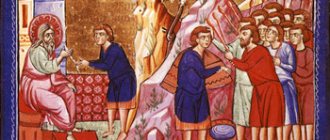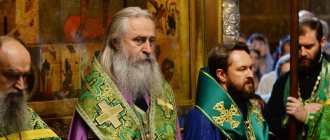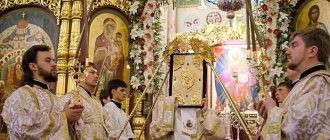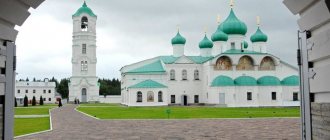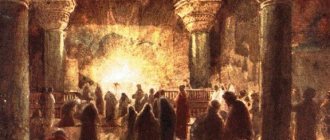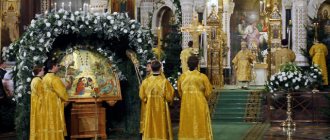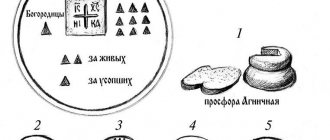A feeling of solemnity. Priests in magnificent robes either line up in a row or form a circle. A religious ritual is underway. It's beautiful, spiritual and mysterious. What is the procedure that priests follow?
It's called liturgy. And early liturgies have been known since very distant times.
The culture of the first Christians is a blank spot for us. Rare written sources help to complement the picture of the past, to learn a little more about the times when Jesus Christ walked the earth. And the more valuable any find is. Every word of the Gospel is a bridge between the Savior and us.
Apostle James
compiled a rite, which was called the Divine Liturgy of the Apostle James
But the apostles may have left us not only an exposition of the teachings of Christ, but also the first church rites.
At least, there is a tradition that the Apostle James compiled a rite from the age of 70, and today we know it under the name the Divine Liturgy of the Apostle James. Is it so? Let us consider what we know about this rank.
Apostle James, the first bishop of Jerusalem, is considered the author of the Liturgy of the Apostle James
The Apostle James is a mysterious person. From the Gospels we know him as the brother of the Lord. But what does it mean? Unfortunately, there is no definite answer. There is an opinion that this man was born to Mary, the Mother of God and Joseph; other theologians consider Jacob to be Christ’s cousin.
The question remains open as to whether Jacob, the brother of the Lord, and Jacob Alpheus, one of the twelve disciples of the Savior and also, by the way, his cousin, are the same person. But more often they are considered different people.
The Apostle James became the first bishop of Jerusalem. Two manuscripts are attributed to him:
- Canonical Epistle of James;
- Apocryphal Proto-Gospel of James.
Around the year 62, Bishop Jacob suffered martyrdom. The holy apostle was thrown from the wing of the Jerusalem Temple and then stoned to death.
November 5
this is the day of remembrance of the Apostle James
The day of remembrance of the Apostle James is October 23 (November 5), as well as the Sunday after the Nativity of Christ.
The Liturgy of the Apostle James was compiled for centuries - until the 10th century
According to legend, the Apostle James wrote one of the first liturgical rites, another author of similar works is the Evangelist Mark. But this position does not stand up to criticism.
It is reliably known that these liturgies were composed much later. However, there is no reason to deny that the later works are based on earlier ones, which could actually have been written by contemporaries of Jesus Christ.
Some terminology:
- Liturgy is worship. During it, the Eucharist (communion) is celebrated.
- Order (rite) is a set of actions (prayers, chants, etc.) for worship.
The Liturgy of the Apostle James is a rite of liturgy.
This order took shape by the 4th century, as we know from historical sources. In particular, researchers note that the clergy, who sit facing the people in the center of the temple, is borrowed from the later liturgy of Nestorius.
There are many other signs that directly indicate a late edition of the order. For example, the use of late language:
- They say about the Holy Spirit that he is Consubstantial with the Father and the Son.
- The Blessed Virgin Mary is called Theotokos.
Also noteworthy are the features of later services, which did not exist in the time of the apostles: to perform the rites, a temple is necessary, where there is probably a veil, an altar, an altar, and incense is burned.
Apostle James, the first bishop of Jerusalem, is called the author of the Liturgy of the Apostle James
Researchers identify several stages in the development of the liturgy of the Apostle James:
- Apostolic period - III - IV centuries.
- Edited by Cyril of Jerusalem - 380s.
- Before the Syrian borrowing - up to 450.
- Early Byzantine time - 450 - VI century.
- Late Byzantine time - until the 10th century.
Over the centuries, there are quite a lot of records and testimonies about the liturgy of the Apostle James. There are several variants of it—more precisely, editions.
Patriarch Proclus and Epiphanius wrote about this rite. And the importance of this information is difficult to overestimate. They allow us to take a fresh look at the period of formation of the Christian church.
Disciples of Christ are not just preachers, but institutes of the sacraments.
It is difficult to say how widely the early forms of worship were represented. We do not know this - nor do we know what the true contribution of the Apostle James was to their formation.
As the first Bishop of Jerusalem, he could obviously be perceived by the people as the founder of everything that arose then.
Two hundred years ago there was a legend that to compile the liturgies of Basil the Great and John Chrysostom they used an abbreviated liturgy according to the rite of the Apostle James.
But this was refuted. In fact, until the 10th century, Byzantine liturgies were often mixed, which is why they borrowed certain features from each other.
The history of the church knows many similar rites, allegedly authored by the apostle. The liturgy of the Apostle James itself has been repeatedly quoted for polemical purposes by both Orthodoxy and Catholicism.
Criticism
Archpriest Konstantin Bufeev sharply criticized the celebration of the Liturgy of the Apostle James, arguing that this liturgy is not included in the Typikon and has a number of serious violations from his point of view, especially the instruction to priests not to place pectoral Crosses on themselves (and to bishops - and Panagia ), which Bufeev interprets almost as a renunciation of Christ, also the abolition of Proskomedia, refusal to use the Liar, Copy, separate communion for the laity, and so on. In addition, Archpriest Konstantin Bufeev believes that the text of this Liturgy cannot completely go back to the Apostle James and, most importantly, the transubstantiation of the Holy Gifts does not occur[4].
The Liturgy of the Apostle James lost popularity in the 9th century, and appeared in Orthodoxy in the 1930s
Until the 9th century, the liturgy of the Apostle James was widespread. It was performed by:
- In Cyprus;
- in Southern Italy;
- in Antioch;
- in Palestine;
- in Georgia.
And in other places. But gradually the liturgies of Basil the Great and John Chrysostom supplanted it. By the time Rus' took over the legacy of Byzantium, this rite of worship was no longer used. Therefore, the Liturgy of the Apostle James was not celebrated on our lands.
However, it did not completely disappear. It was served in Jerusalem and on the Greek island of Zakynthos in the 19th century. In both cases the language is Greek. But they also perform the liturgy in Arabic; such a rite exists in the East Syrian Church.
1870
this year the Liturgy of the Apostle James was translated into Russian
The Russian spiritual mission first decided to translate the liturgy of the Apostle James in the 1870s, when it was in Jerusalem. But this translation was not used, and was not intended for worship. His task was different - scientific.
But for divine services, abbot Philip Gardner first took on the translation of the text of the liturgy of the Apostle James in 1938.
Liturgy of the Apostle James in the Orthodox Church
Another translation appeared in 1948, made by Bishop Parthenius.
This is how the liturgy of the Apostle James appeared in the Russian Orthodox Church.
Then it was introduced into services in other Orthodox churches: in Bulgaria, Serbia, etc.
Service of the Liturgy of the Apostle James in the Russian Orthodox Church:
- January 8;
- January 17;
- November 5.
The ancient liturgy is also consulted on other days. The frequency of liturgies depends solely on the wishes of the main clergy of the temples.
About heresies and liberalism.
According to the website of the St. Petersburg Theological Academy (spbda.ru/news/v-akademii-sovershena-liturgiya-apostola-iakova/) November 4, 2021, on the eve of the memory of the holy Apostle James, brother of the Lord, in the academic church of the Apostle and Evangelist John The theological rector of the St. Petersburg Orthodox Theological Academy, Archbishop of Peterhof Ambrose (Ermakov), again celebrated “the liturgy according to the rite of the Apostle James, the brother of the Lord.” The last few years have seen a sudden surge of interest in the liturgy of St. James. The non-statutory rite, which had never been served in the churches of our Church since the Baptism of Rus', suddenly began to be carried out in some parishes, in some monasteries and even in some religious educational institutions. This phenomenon can not be called either canonical or traditional. There is a kind of reform epidemic, and this “renovationist renaissance” is gaining momentum in the Russian Church before everyone’s eyes. Moderate champions of modernist practice hold a Jerusalem rite on the feast day of the Holy Apostle James on October 23. More active reformers-neo-renewalists add to it the week after the Nativity of Christ (when the memory of James, the brother of the Lord is celebrated together with the memory of King David and the righteous Joseph the Betrothed) and the Council of the 70 Apostles (among whom James, the first bishop of Jerusalem, is honored). The most unrestrained followers of Gardner (he will be discussed below) serve the Liturgy of the Apostle James almost every week. Information about this is publicly available on the Internet. The impulse to liturgical “creativity” is a consequence of an internal crisis, which forces us to look for the source of disorder not “in ourselves,” but in external conditions, that is, to “correct the Church.” The reasons for the daring rejection of canonical statutory requirements may be different. Sometimes satiety with serving according to the usual rites or dissatisfaction with peaceful and blissful church prayer leads to the renewal itch. Another reason may be prideful ignorance, expressed in insufficient knowledge and understanding of the Charter. Often modernists and liturgical reformers are driven by the desire for originality, the search for new sensations. The most dangerous thing for Orthodoxy should be recognized as the tendency of some people to deliberately undermine the church tradition, to “enrich” it with third-party additions. This sin of foreignness is provoked by a reformist (essentially rebellious Protestant) spirit, hiding behind a pseudo-pious motive to serve “as in the ancient Church.” In those churches where the liturgy of the Apostle James is “legalized” and practiced regularly (as in the St. Petersburg Church of the Theodore Icon of the Mother of God), a modernist desire to abolish the iconostasis and reduce the Royal Doors to Lilliputian sizes is noticeable - so that they are practically absent and do not close at all altar. This tendency was previously demonstrated by the renovationists of the 20s and 90s (Bishop Antonin Granovsky, priest Kochetkov), who more than once stated that they perceived the iconostasis and the Royal Doors as a “interference.” This should be seen as a manifestation of the moderate iconoclasm of the Protestant reformers (from church history it is known that if with active iconoclasm icons were destroyed, then with moderate iconoclasm they were moved away or abolished).
Adherents of the service of the Liturgy of the Apostle James present it as a “revival of a 2000-year-old tradition” and a “return” to Eucharistic origins. At the same time, they turn a blind eye to the fact that these slogans are very far from the truth. There are too many lies being said about this liturgy, which are repeated word for word on various Internet sites: as if the liturgy of the Apostle James is completely “statutory”, originally “apostolic” (but this is not so, since it is of the same century as the liturgies of Basil the Great and John Chrysostom), that its ministry “was not interrupted for two thousand years” (not true, since it had a thousand-year break), as if the service of this liturgy was completely “traditional” (not true, since its modern spread is the fruit of the artificial activity of Greek and Russian reformers). It is noted that the rite of the Liturgy of the Apostle James is replete with many unusual “oddities.” At the same time, they are “embarrassed” to give a fundamental spiritual assessment to overt manifestations of wickedness, as discussed below. At this “liturgy”, in addition to the Apostle and the Gospel, the Old Testament is read, it is not necessary to perform Proskomedia. The priests perform the Liturgy of the Apostle James without pectoral crosses.
In the rite of the Liturgy of the Apostle James, the bishop is asked not only to renounce the Cross and Panagia, but is also prohibited from using such sacred objects as the Dikirius, Trikirii, Ripidy and Orletsa: “The Dikirii and Trikirii are not needed at this liturgy, below Orletsa.” As noted in the rite of the liturgy of the Apostle James, coverings are not placed on the sacred vessels - Paten and Chalice: "without covering the vessels, he departs." The traditional service book indicates the need for the following symbolic action. After crushing the particles of the Lamb for the communion of the laity and immersing them in the Chalice, the priest “covers the holy Chalice with a shroud.” Thus, after the opening of the Veil and the Royal Doors, the communicants “with the fear of God and faith” look at the Risen Christ, clothed in the robe of the glory of God (which is symbolized by the cover). In the same image of the Divine Glory, Jesus the Flesh-Bearer performs His Ascension, when the Chalice decorated with a shroud (containing the particle “IS”!) is transferred from the Throne to the Altar, located in the depths of the altar, impenetrable to the eyes of the worshipers. In church tradition, coverings and air have been used for many centuries, and it is not clear how they can interfere with the celebration of the liturgy according to the new rite. The rite of the Liturgy of the Apostle James does not provide for the use of the Liar and the Copy. The liar symbolizes a reed with a lip (John 19:29) soaked in vinegar and bile. In this image, she is placed next to the altar Cross - the image of the Crucified Savior. The liar serves as a means of communion for the laity. Then she is associated with tongs, with which the burning coal of the Eucharistic Shrine is placed into human mouths (“I commune with fire, grass”). Finally, she represents the image of the Most Holy Theotokos herself, the “mysterious pincer” (Service of the Presentation), through whom sinners are granted forgiveness of sins and sanctification. The Spear is a thin knife of a special shape, symbolizing the Spear with which the side of the crucified Savior was pierced. Without a Copy it is impossible to carve a Lamb from a prosphora. At proskomedia it is also used when cutting the sacred bread with the words: “The Lamb of God is eaten, take away the sin of the world.” In addition, the Spear is used in the symbolic action of piercing the side of the Savior with the pronunciation of the Gospel words: One of the warriors pierced His side with a spear... (John 19:34). During the cathedral service, the copy is solemnly worn from the altar, which emphasizes the symbolic meaning of the Great Entrance - the procession of the Lord Jesus to voluntary mortal Passion. At the end of the Entrance, the Spear is placed on the Throne. Together with the Liar, it makes up the canonical pair of attributes “Spear and Reed” near the altar Cross. This visual image of the Passion of Christ remains on the throne until the completion of the anaphora. The rite of the liturgy of the Apostle James does not provide for the infusion of warmth into the Chalice before communion. According to the generally accepted order in the Church, it is necessary to add boiling water - heat - to the Chalice. This water is blessed and poured into the Chalice with the words: “Warmth of faith, fill with the Holy Spirit.” By the way, in Gardner’s (see about Gardner below) rite it is noted that on the island of Zakynthos “warmth pours into the holy Chalice.” This indicates that the widespread Orthodox custom, if desired, could (and should!) be observed and not rejected. A bishop should not wear either Sakkos or Mithra. All elements of the bishop’s rite are carried out “according to a simplified scheme.” This clearly deprives the service of that deep symbolic content that occurs at traditional hierarchal services. In the rite order, the bishop and priests are prescribed to sit in the middle of the church with their backs to the Throne with the Royal Doors open: the seat of the bishop and the “seat of the presbyter” are set “visually to the west.” During the reading of the proverbs and the Apostle: “And the saint will sit in his place, and command the presbyter to sit down, while the deacons stand behind, that is, from the eastern country of the pulpit, along both sides of it, two two, looking towards the west.” Everyone, even the participants in the liturgy, calls this custom “strange” and “unusual.” We would dare to call him contrary to the generally accepted norms of Orthodox piety. Let us note that the expressions “with their back to the Throne” or “with their back to the altar” are more accurate when describing the sitting of the clergy at the Liturgy of the Apostle James than the expression “facing the people” or “sighting to the west.” In the Orthodox (and, by the way, also in the Catholic) tradition, during the reading of the Apostle and Proverbs, the bishop and presbyters sit on the High Place of the altar - “facing the people,” but not “with their backs to the Throne”!
In the rite of the Liturgy of the Apostle James, immediately after the initial exclamation and two short priestly prayers, the Small Entrance is performed. There is no provision for the singing of antiphons, troparions, or kontakions; the deacon at the Liturgy of the Apostle James proclaims all prayer calls, standing with his back to the Throne and facing the people (“to the people”). (“And the deacon speaks before the Holy Doors, in vain to the people, in a litany.”) It is not possible to verify whether this was the case in the ancient Church. But in the Orthodox tradition, it has long been customary to invite people to prayer in the form of joint action: not “pray!”, but “let’s pray!” (with the exception of “Pray the Catechumen of the Lord!”, “Catechumenate, come forth!”). Traditionally, the role of a deacon is that he gives a pious example of prayer, involving all the faithful in spiritual aspiration to the Almighty.
In the 70-80s of the 20th century, at the St. Petersburg Theological Academy, a similar practice of serving the “liturgy of the Apostle James” arose on the initiative of the modernist metropolitan Nikodim (Rotov), but with his death the celebration of this liturgy ceased. For the first time after a many-year break, on November 5, 2010, in the academic church in honor of the holy Apostle and Evangelist John the Theologian, “the liturgy according to the rite of the Apostle James, brother of the Lord,” was celebrated by Bishop Ambrose (Ermakov) of Gatchina. Since then, the service of this “liturgy” within the walls of SPbPDA has been held annually. The book regulating Orthodox worship is called the Typikon or Charter. It provides for the service of one of three liturgies - Basil the Great, John Chrysostom and the Presanctified Gifts. The Typikon determines which of them should be served on each day of the church year. The Typikon does not allow for the possibility of influence on the choice of liturgy by local traditions or patronal feasts. The Typikon does not make the choice of liturgy dependent on local traditions. The specifics of worship on patronal feast days are indicated in special “church chapters,” which provide for service according to the solemn rite “with vigil.” All these cases are regulated by the Typikon, and therefore they are not “exceptions” of any kind. Thus, if the patronal feast of Great Lent falls on Monday, Tuesday or Thursday, the Liturgy of the Presanctified Gifts should be served. This means that in all Orthodox churches, each specific holiday is supposed to serve the same liturgy. And in this the liturgical unity of the Church is manifested. The Typikon does not allow the replacement of one liturgy with another on the principle of “as the abbot wills.” This rule does not apply to the choice of the type of liturgy. The purpose of the liturgy is not determined by human arbitrariness. The Charter does not allow any replacement of one rite of the liturgy with another at the discretion of the rector. In case of forced impossibility of serving, the liturgy may be canceled - but not replaced with another! This is stated in the Typikon in the section: “If there is some great need for the sake of the memory of the Holy great polyeleos, there will not be a Presanctified Liturgy” (February 24, 11th Mark chapter, 5th See). It is also noted in the section “On the Holy and Great Week of Easter” of chapter 50: “What if, due to need, there will be no liturgy” (1st Zri). In some other issues, the Charter allows for different interpretations and alternatives. But the type of liturgy is clearly regulated by the current Typicon, leaving no freedom of choice for anyone: neither the rector of the church, nor the dean, nor the diocesan bishop have the power to arbitrarily change this requirement of the Church Charter. The Typikon's instructions on the choice of liturgy are mandatory for all parishes, monasteries and cathedrals, so everyone must obey them - from the Patriarch to the layman. Celebrating the liturgy according to an erroneously chosen rite is a canonical violation. The wrong choice of rite when serving the Divine Liturgy is considered a serious sin. It is comparable to similar canonical violations, such as if the performer of the liturgy were a person who does not have holy orders or is under a ban; or if instead of red grape wine, another liquid was poured into the Chalice (for example, berry juice or honey syrup); or if instead of wheat prosphora, another bread product would be used (for example, unleavened or barley bread); or if the “correct” liturgy was served on a day when its holding is prohibited by the Charter (for example, on Wednesday of Cheese Week or on the first Monday of Lent). The transubstantiation of the Holy Gifts occurs, according to the faith of the Church of Christ, only at a correctly performed Eucharistic service. The grace of the Holy Spirit does not work where they deliberately commit a canonical crime. The sacrament is performed in the Church only under the condition of reverent observance of its canonical rules, and not where the liturgical Rule is violated. No one will force Orthodox people to believe that at the anti-statutory liturgy, bread and wine are transformed into the Body and Blood of Christ... Of course, the Tradition of the Church contains examples of miraculous exceptions, when no human sins or canonical violations could prevent the performance of the sacrament. The Lord is able to impart grace to His faithful always and everywhere - both during persecution and in places of imprisonment. The Spirit who breathes where he wants (John 3:8), can, according to the faith of a righteous person, give him communion “not in judgment or condemnation” of the true Holy Gifts - even from the hand of the most illiterate and unworthy priest who serves “wrong” , “not then” and “not that”. However, we should not forget the Gospel commandment: Thou shalt not tempt the Lord thy God (Matthew 7:4, see also Deut. 6:16)! The one who deliberately subverts the Charter of the Holy Orthodox Church angers God. He must bear personal responsibility before the Church Court. When Archimandrite Zinon (Theodore) on August 15, 1996 allowed, at his own discretion, in the Mirozh Monastery, instead of serving the Liturgy of St. John Chrysostom, the celebration of the Mass according to the Catholic rite and he himself participated in it, he was banned from serving for this canonical crime by the ruling bishop Eusebius, Archbishop of Pskov. What liturgy, according to the Typikon, should be served on the day of memory of the Holy Apostle James? Liturgy of John Chrysostom. On what day in the circle of the church year, according to the current Charter of the Russian Orthodox Church, should the Liturgy of the Apostle James be served? There is no such day in Monthly. The Typikon does not provide for any “liturgy of the Apostle James”. The corresponding rite is not contained in any officially published priestly Service Book or in any bishop's Official. We do not find any indication of the service of such a “liturgy” either in the Menaion, or in the Octoechos, or in the Triodion. In the centuries-old liturgical tradition of the Russian Church, there was no such liturgy at all until very recently. Therefore, serving the Liturgy of the Apostle James is an unconditional canonical violation. The text of the so-called “Liturgy of the Apostle James” is certainly not a historical monument of the 1st (apostolic) century. The text of the Eucharist, known by this name and existing in several different Syriac and Greek versions that have come down to us, was probably formed in the same 4th century on the basis of older Eucharistic rites that have not come down to us. The edition attributes its authorship to the first bishop of the Mother of Churches, James, the brother of the Lord, whom the Apostle Paul mentioned (Gal. 1:19). However, we should not forget that all the time from the destruction of Jerusalem in the 1st century by the troops of Emperor Titus until its restoration in the 4th century under the holy Equal-to-the-Apostles Emperor Constantine the Great, neither the city itself nor even its name existed: at the beginning of the 2nd century it was renamed “Elius” -Adrian" and turned into a pagan temple. Until the 4th century, there was no local “Church of Jerusalem” with its special “apostolic” tradition - otherwise in the diptych of Churches it would not have been in fifth place after the Roman, Constantinople, Alexandria and Antioch. The name of Saint James of Jerusalem is, rather, not an indication of historical authorship, but a symbol of the apostolic origin of the Eucharist. Before the 4th century, there is no reliable information about the liturgy of the Apostle James. After the 5th century, it, along with the liturgies of Basil the Great and John Chrysostom, was preserved as a local Jerusalem rite. It was never widespread in other provinces of the Roman Empire. But even in the Holy Land it was served only once a year, and therefore was not considered statutory and normative, equal in importance to the Byzantine liturgies. By the 10th century, even in Jerusalem, her ministry had practically ceased. The Liturgy of the Apostle James is common in heretical communities outside the Catholic Church. The formation of their own liturgical tradition, in parallel with Byzantium, took place in those local churches that, during the era of the Ecumenical Councils, separated from Catholic Orthodoxy. In particular, this liturgy took root among the Copts, Syro-Jacobites and other Monophysites. Dozens of different Syriac editions of it are known, dating after the Council of Chalcedon. Among the heretics - Nestorians and Monophysites - the process of forming their liturgical canon proceeded independently and independently. At the same time, they always insisted on the apostolic antiquity of their liturgical tradition. It is noteworthy that both of them attribute their own Eucharistic tradition specifically to the liturgy of the Apostle James (perhaps, under the influence of these claims, a version of its “apostolic” origin arose?..). It is not surprising that the liturgy of the Apostle James found a home in heterodox communities. The Liturgy of the Apostle James was never used in Rus'. By the time of the reign of the Holy Equal-to-the-Apostles Grand Duke Vladimir, the Byzantine canon had already been fully formed. The Liturgy of the Apostle James was not included in this canon. Until the 20th century (!) it was not even translated into Church Slavonic, and therefore it was not served by the Slavs either on the Balkan Peninsula or in Rus'. There is no mention of it in any Typikon. On the contrary, the liturgies of Basil the Great and John Chrysostom were established both in the Russian Church and throughout the Orthodox world. They are included as an integral part in all Typicons and, in the proper sense of the word, have become an expression of the church's liturgical tradition. By the beginning of the second millennium, the Liturgy of the Apostle James in the Orthodox world (unlike the non-Chalcedonian churches) ceased to be served. As noted in her rite, “in this way the tradition of this divine service has been extinguished.” Until the middle of the 19th century, her ministry was not resumed. The Greeks themselves remembered this rite only a thousand years later, when the reformatory revival of their church life, which had fallen into decline during the rule of the Turkish Sultan in the Balkans and Asia Minor, began. The reason for remembering the long-forgotten liturgical rite was the renovationist reformation in the Church of Constantinople. It began in 1838, when a new Typikon was drawn up. A similar “tradition” appeared at the same time on the Greek island of Zakynthos on the initiative of the modernist archbishop Dionysius II Latas († 1894), who was inspired by the reformist idea of serving a long-vanished liturgy and arbitrarily revived the forgotten ancient worship in his island diocese. Similar attempts were made in some other places, but, in general, they remained a rare and rather marginal phenomenon. The sketch made by the translator Gardner, who was then in the rank of hieromonk, is quite consistent with the end of the 19th century: “In Jerusalem, once a year, on October 23, on the day of remembrance of the holy Apostle James, brother of the Lord, the Divine Liturgy of the holy Apostle James is celebrated.” However, in the 20th century the situation changed. In 1937, when these words were written, they were already very far from the historical truth. Soon there was no one to support the new initiative. In the 20th century, the Liturgy of the Apostle James was not celebrated in Jerusalem for many years. Let us present evidence from the journal of the Russian Church Abroad for 1936, which describes the first celebration of this liturgy by His Beatitude Patriarch Timothy of Jerusalem: “The last time this liturgy was celebrated in Jerusalem 35 years ago, and if His Beatitude the Patriarch had not restored its celebration, there would have been danger “that the tradition of how to perform it will be forgotten and cease.” This exotic liturgy looked less like a prayer rite and more like a spectacle for the curious or like a museum performance in the style of a church retro performance. Two presbyters and four deacons took part in the ceremony. The Patriarch served without the Cross, Panagia and Miter. Many spectators gathered to look at the outlandish rite. Among those present was Hieromonk Philip (Gardner). Having once attended an unusual service, he was inspired by the idea of translating it into Church Slavonic. Neither Saint Tikhon, nor his successors, the Most Holy Patriarchs, blessed in our Church the official publication of the liturgical translation of the liturgy of the Apostle James. The situation in Russian emigrant circles was different. The text of the Liturgy of the Apostle James was translated from Greek by the ROCOR cleric Hieromonk Philip (Gardner) and published in pre-revolutionary Russian orthography on February 10, 1937 in Jerusalem. A year later, on July 27, 1938, he himself, but already in the rank of abbot, published the second edition of this liturgy, printed in Church Slavonic script “in Vladimirova in Pryashevskaya Rus” (Carpatho-Rus'). As the translator noted, he was the first compiler of this service in Church Slavonic: “For the Russian Church does not know this service, lower than the other Churches of the Slovenian peoples.” Thus, neither in the Serbian, nor in the Bulgarian local Churches, nor on Mount Athos, this liturgy had never been served in Church Slavonic before. For the first time this liturgy was held in Church Slavonic in the Russian Church of the Life-Giving Trinity in Serbia, in Belgrade on January 18, 1938 - that is, six months before the publication of its Slavic text. It is somewhat strange that the chosen day has nothing to do with the memory of Saint James of Jerusalem, but for some reason coincided with the day of remembrance of Saints Athanasius and Cyril, the Patriarchs of Alexandria. The celebrant of the liturgy was the same initiator: “To the celebrant of the liturgy, Higumen Philip (Gardner), to whom this liturgy was translated from Greek into Slovenian.” One protodeacon participated in the concelebration. Four bishops of the ROCOR, led by Metropolitan Anastasius (Gribanovsky), were invited to this liturgy, but they did not take any part in the service, but are mentioned only as “those present.” This new-fashioned liturgy was clearly not popular among the Russian people “in the diaspora,” since it did not in the slightest connect the emigrants either with the Fatherland or with their native Orthodox church tradition. The further church career of the translator of the liturgy of the Apostle James into Church Slavonic and its first minister was indicative. On June 14, 1942, in Berlin, during the height of the Great Patriotic War, the consecration of Abbot Philip (Gardner) as Bishop of Potsdam, vicar of the Berlin and German Diocese of the ROCOR took place. The further zigzag of fate turned out to be like this. Two years later, Gardner resigned his monastic and episcopal ranks... and got married. In 1944, he was dismissed from his position as Berlin vicar and rector of the Cathedral of the Resurrection in the German capital. After 6 years, he was officially deprived of his episcopate by the Synod of the ROCOR. It is not our place to judge other people's slaves (Rom. 14:4). But how can one not remember in connection with this inglorious story that shortly before he renounced his monastic vows and finally took off the Panagia and the Cross, “Higumen Philip” for the first time took off the Cross for the sake of serving the non-statutory liturgy? After all, the condition “not to lay” the Cross on oneself by his hand is written as a mandatory requirement for all priests who begin to serve the Liturgy of the Apostle James: “In the same way, one does not lay the Cross on oneself.” Spiritual fornication and rejection of the Cross of Christ led Gardner, in a matter of years, to carnal fornication and betrayal of church pastoral service. Let us note in this regard one undoubted superiority of the Slavic text of the Byzantine liturgies over the Slavic version of the liturgy of the Apostle James. The translation of the liturgies of Basil the Great and John Chrysostom was made for us by God-inspired men - Equal-to-the-Apostles Cyril and Methodius. The important thing is that we, the Slavs, accepted the liturgical heritage of the ancient teachers of the Church as Sacred Tradition from the hands of the Saints. In contrast, the “Liturgy of the Apostle James” was translated into the Slavic language by Gardner, who was driven by dubious motives and did not remain faithful to his pastoral service in the Church. The current initiators of introducing this rite into use in the Russian Church should think hard: is it worth so trustingly accepting spiritual food from the hands of such a “mentor” (compare: Heb. 13:7)? Each of these differences does not simply represent a rejection of technical innovations such as the use of electricity or a gas lighter. Everything listed above and rejected by Gardner is an organic part of a single sacred rite, formed by the centuries-old tradition of Orthodox worship. All liturgical elements are interpreted symbolically and are distinguished by grace and perfection of form. Refusal of Tradition makes Christians defenseless against external spiritual influence, since many rituals were approved for the sake of confessing Orthodox principles, as opposed to heretical false teachings (Docetism, Monophysitism, iconoclasm, etc.). The rejection of Crosses, icons, and symbolic actions has no justification after the Church, in response to yet another dogmatic distortion, approved them. It is a commendable task to prepare for the academic publication of ancient written monuments, accompanied by careful work on their translation. However, Gardner’s rite offers something completely different: “This publication is not a scientific-archaeological publication, but is a publication of a liturgical-living rite.” In this case, what is happening is not an in-depth disclosure of the Orthodox tradition, but an impoverishment of the symbolic meaning of many rituals, the robbing of the great liturgical wealth accumulated by the Church. The main driving motive for supporters of the service of the Liturgy of the Apostle James is the desire to join the ancient apostolic worship. The desire is laudable. At the same time, it seems strange that while certain archaic forms are preserved, a significant part of the order consists of fragments of obviously later compositions. There are other known editions of the rite of the liturgy of the Apostle James in Church Slavonic in the 20th century. The third edition of the rite of the Liturgy of the Apostle James in Church Slavonic, identical to the second, was published in 1970 in Rome. The beginning of the service of this liturgy in Russia is directly connected with the mentioned Roman publication, and this is a very remarkable story. In this city, more precisely in the Vatican, the chairman of the Department for External Church Relations of the Moscow Patriarchate, Metropolitan Nikodim (Rotov) of Leningrad and Ladoga, often visited this city as part of his official duties. Soon after the Roman publication of the Liturgy of the Apostle James, he initiated its annual service at the Leningrad Theological Seminary and Academy. This innovation continued until the death of the bishop, which followed in 1978 in Rome, and stopped immediately after his death. Thus, through the emigrant Abroad and the Catholic West, which had been cut off from its native soil, the rite of the liturgy of the Apostle James penetrated into the bosom of our Church for the first time in history. As a result, this strange liturgy was held several times on Russian soil. Under His Holiness Patriarchs Pimen and Alexy II, the service of this extravagant liturgy was not resumed in any diocese of the Russian Orthodox Church. How should Orthodox people feel about celebrating the Liturgy according to an incorrectly chosen rite (if this suddenly happens)? Clerics and laity who have the fear of God should wisely avoid participating in obviously anti-statutory liturgical actions, especially if they are presented under the guise of “correct”. Otherwise, there is a high probability of becoming unwittingly guilty of blasphemy or other sins against the Holy Spirit. Serving the “wrong” liturgy is comparable to such unacceptable actions as performing the sacrament of marriage over monks, or holding daily services with the Royal Doors closed on Easter Week, or serving the usual prayer service instead of the rite of the Great Blessing of the Water on Epiphany Eve. Grace is not given from God when committing such atrocities. Participation in them is a sin.
In order not to indulge the spread of vicious renovationist liturgical practice under the guise of the anti-canonical “liturgy of the Apostle James,” we can recommend that Orthodox believers refrain from visiting churches where such liturgical modernist experiments are carried out.


